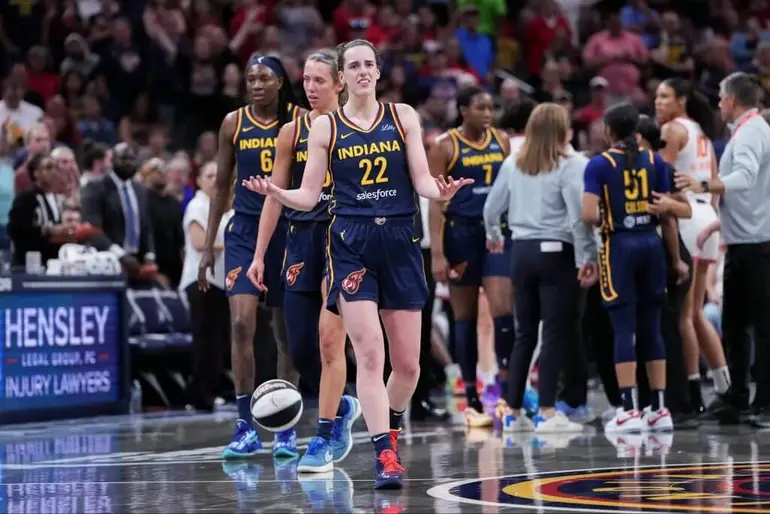The latest WNBA controversy has once again ignited a firestorm of debate, frustration, and scrutiny surrounding the league’s officiating, and it’s a conversation that can no longer be brushed aside. As the popularity of the WNBA surges to unprecedented heights—thanks in part to dynamic stars like Caitlin Clark, A’ja Wilson, Breanna Stewart, and others—it’s becoming glaringly obvious that the quality of officiating is struggling to keep pace with the league’s evolution. What unfolded in the most recent series of questionable calls, non-calls, and outright missed plays has drawn the ire of players, coaches, fans, and analysts alike. This isn’t just about a blown whistle here or there; it’s about the integrity of the game, the safety of the athletes, and the long-term credibility of a league that is increasingly capturing the attention of the sports world.
This controversy doesn’t exist in a vacuum. It’s part of a growing trend that’s becoming harder and harder to ignore. As the WNBA becomes more physical, competitive, and intense, fans have seen repeated moments where officials appear overmatched or inconsistent in their judgments. When calls are inconsistent or when obvious fouls are missed in critical moments, the ripple effect is massive. It not only impacts the outcome of games but also affects the morale of players and the perception of fairness throughout the league. For years, players have voiced their frustrations in press conferences, on social media, and sometimes even during games, only to be met with fines or warnings for “criticizing the officiating.” But now, the voices are louder, more unified, and more determined than ever to demand accountability.
What has intensified this latest uproar is that it involved one of the league’s most visible stars. When a high-profile player is repeatedly on the receiving end of missed calls or overly physical play that goes unchecked, it magnifies the problem tenfold. Fans who might be watching WNBA games for the first time are left bewildered. Longtime supporters feel insulted. And players are left questioning whether the system is built to protect them. The controversy doesn’t just highlight poor officiating—it exposes a structural issue that could stunt the league’s growth at the very moment it’s poised for a breakthrough.
The league has made strides in many areas, from marketing and expansion to broadcasting and player empowerment. But officiating has remained a blind spot. While the NBA has invested heavily in training, evaluating, and holding referees accountable through programs like the Last Two Minute Report, the WNBA appears to be lagging behind. There is a visible disconnect between the speed and skill level of today’s WNBA athletes and the ability of the officiating crews to accurately call the game. That disconnect leads to increased frustration on the court, heightened tensions between players and officials, and ultimately, a diminished product for fans.
The problem isn’t just about competency; it’s also about consistency. Coaches and players can accept a tight whistle or a loose one—what they can’t accept is unpredictability. When one game features borderline fouls called with surgical precision and the next allows near-mugging in the paint without so much as a whistle, it creates a chaotic environment. Strategy becomes more difficult to implement. Players become hesitant or overaggressive. And coaches lose their ability to manage games effectively. In short, the game suffers.
Furthermore, the perception of bias—whether real or imagined—can take root quickly in an environment with shaky officiating. Every missed call against a young rookie like Caitlin Clark, or every non-call when a veteran is hammered driving to the rim, chips away at trust. That erosion of trust is dangerous. Sports leagues thrive on the belief that competition is fair, outcomes are determined by talent and effort, and the officials are merely stewards of the rules. When that belief is lost, the foundation begins to crack.
The timing of this controversy is particularly unfortunate given the current spotlight on the league. More people are watching WNBA games than ever before. Social media is ablaze with highlights, commentary, and passionate debates. Major brands are partnering with players. And attendance is steadily climbing. All of these signs point to a league on the rise. But the officiating controversy is acting as a persistent thorn in the side of progress. It’s creating headlines for all the wrong reasons, and those headlines risk overshadowing the phenomenal level of play on the court.
To be fair, officiating is an incredibly difficult job. Officials must make split-second decisions in fast-moving situations, often while dealing with high levels of pressure from players, coaches, and fans. Mistakes are inevitable. But in the WNBA, the margin for error feels too wide, and the accountability mechanisms too weak. It’s not enough to simply acknowledge that officiating is hard work. The league must prioritize it, invest in it, and modernize it. That means better training, more rigorous evaluation, and transparency when things go wrong.
There’s also a safety concern that can’t be overlooked. When physical play escalates and officials fail to get control of the game, players are at increased risk of injury. The WNBA season is grueling, and most athletes play year-round between international leagues and stateside commitments. Their bodies are already under tremendous strain. Add in unchecked fouls, retaliatory play, and lack of officiating protection, and the danger becomes real. One severe injury resulting from a missed or ignored foul could set a player back for months—or longer—and alter the trajectory of a career. That’s not just a competitive issue; that’s a human one.
The players are doing their part. They’re elevating the game, drawing attention to the league, and showing up night after night ready to perform. The fans are doing their part too, packing arenas, engaging online, and advocating for the sport. Now it’s time for the league office to do its part. This means addressing officiating not as a secondary issue, but as a central one. It should be at the top of the agenda in boardrooms, committee meetings, and developmental discussions.
One potential solution is the implementation of a more advanced replay system or challenge structure that allows coaches to contest critical calls. Another is greater transparency, such as public postgame officiating reports that clarify decisions and take ownership of mistakes. These steps won’t eliminate human error, but they can go a long way in restoring confidence and reinforcing that the league is serious about officiating excellence.
There’s also a glaring need for an increase in the overall pool of qualified officials. The WNBA should consider working in closer partnership with officiating pipelines from the NCAA, the NBA, and international circuits. Creating incentives for top-tier officials to join the WNBA and stay long-term could stabilize the quality of officiating and build a stronger foundation for future growth. This would require investment, but it’s the kind of investment that pays off in both performance and perception.
The message from this latest controversy is not just one of criticism—it’s also a call to action. The league has the momentum. It has the talent. It has the audience. But it cannot afford to let inconsistent officiating become the narrative that defines this era. Fairness, accuracy, and accountability must become non-negotiable standards. Because the players deserve it. The fans expect it. And the future of the WNBA depends on it.
Ultimately, the WNBA is not just a league—it’s a movement. And movements are built on trust, progress, and integrity. If the league wants to continue climbing, if it wants to set a new standard in women’s sports, it must confront this officiating crisis head-on. The game has never been better. The athletes have never been more inspiring. Now it’s time for the whistles to catch up.



